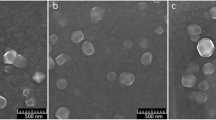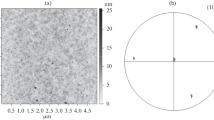Abstract
This work is devoted to the development and study of in situ controlled process of the formation of porous anodic alumina and Al nanomesh from thin aluminum films deposited by a direct current magnetron on glass substrates with an adhesive layer of Nb. In order to control in situ anodic oxidation processes during the formation of the structure of PAA-Al nanomesh and the removal of PAA by etching, the method of monitoring of an angular reflection curve was applied. The obtained Al nanomesh was studied by the SEM method. Particular attention is paid to the connection between the features of the initial thin-film structures and the formed Al nanomesh.
Access this chapter
Tax calculation will be finalised at checkout
Purchases are for personal use only
Similar content being viewed by others
References
Losic D, Santos A (2015) Nanoporous alumina: fabrication, structure, properties and applications, Springer Series in Materials Science, vol 219. Springer, Cham
Choi J, Nielsch K, Reiche M, Wehrspohn RB, Gosele U (2003) Fabrication of monodomain alumina pore arrays with an interpore distance smaller than the lattice constant of the imprint stamp. J Vac Sci Technol B 21:763–766
Ottone C, Laurenti M, Bejtka K, Cauda V (2014) Effects of the film thickness and roughness in the anodization process of very thin aluminum films. J Mater Sci Nanotech 1(1):1–9
Lita A, Sanchez JE (1999) Characterization of surface structure in sputtered Al films: correlation to microstructure evolution. J Appl Phys 85(2):876–882
Lebyedyeva T, Kryvy S, Lytvyn P, Skoryk M, Shpylovyy P (2016) Formation of nanoporous anodic alumina by anodization of aluminum films on glass substrates. Nanoscale Res Lett 11:203
Li Y, Chen Qiu M, Yu H, Zhang X, Sun XW, Chen R (2016) Preparation of aluminum nanomesh thin films from an anodic aluminum oxide template as transparent conductive electrodes. Sci Rep. https://doi.org/10.1038/srep20114
Kazarkin B, Mohammed AS, Stsiapanau A, Zhuk S, Satskevich Y, Smirnov A (2014) Transparent conductor based on aluminum nanomesh. J Phys Conf Series. https://doi.org/10.1088/1742-6596/541/1/012027
Smirnov A, Stsiapanau A, Mohammed A, Mukha E, Kwok HS, Murauski A (2011) Combined nanostructured layers for display applications. Proceedings SID symposium display week-2011 Los-Angeles, USA, pp 1385–1387
Dadivanyan AK, Belyaev VV, Chausov DN, Stepanov AA, Smirnov AG, Tsybin AG, Osipov MA (2015) Nanomesh aluminum films for LC alignment. Theoretical and experimental modeling. Mol Cryst Liq Cryst 611(1):117–122
Hubarevich A, Marus M, Stsiapanau A, Smirnov A, Zhao J, Fan W, Wang H, Sun X (2015) Transparent conductive nanoporous aluminium mesh prepared by electrochemical anodizing. Phys Status Solidi A Appl Mater Sci 212(10):2174–2178
Gao J, Kempa K, Giersig M, Akinoglu EM, Han B, Li R (2016) Physics of transparent conductors. Adv Phys 65(6):553–617
Stadler A (2012) Transparent conducting oxides – an up-to-date overview. Materials 5:661–683
Kumar A, Zhou C (2010) The race to replace tin-doped indium oxide: which material will win? ACS Nano 4:11–14
Ellmer K (2012) Past achievements and future challenges in the development of optically transparent electrodes. Nat Photon 6:809–817
Song TB, Li N (2014) Emerging transparent conducting electrodes for organic light emitting diodes. Electronics 3(1):190–204
Zhou Y, Azumi R (2016) Carbon nanotube based transparent conductive films: progress, challenges, and perspectives. Sci Technol Adv Mater 17(1):493–516
Park S, Vosguerichian M, Bao Z (2013) A review of fabrication and applications of carbon nanotube film-based flexible electronics. Nanoscale 5(5):1727–1752
Rana K, Singh J, Ahn JH (2014) A graphene-based transparent electrode for use in flexible optoelectronic devices. J Mater Chem C 4(2):2646–2656
Sannicolo T, Lagrange M, Cabos A, Celle C, Simonato JP, Bellet D (2016) Metallic nanowire-based transparent electrodes for next generation flexible devices: a review. Small 12(44):6052–6075
Guo C, Ren Z (2015) Flexible transparent conductors based on metal nanowire networks. Mater Today 18(3):143–154
Luo M, Liu Y, Huang W, Qiao W, Zhou Y, Ye Y, Chen LS (2017) Towards flexible transparent electrodes based on carbon and metallic materials. Micromachines 8(12):1–16
Wu H, Kong D, Ruan Z, Hsu PC, Wang S, Yu Z, Carney TJ, Hu L, Fan S, Cui Y (2013) A transparent electrode based on a metal nanotrough network. Nat Nanotechnol 8(6):421–425
Nielsch K, Choi J, Schwirn K, Wehrspohn RB, Gosele U (2002) Self-ordering regimes of porous alumina: the 10% porosity rule. Nano Lett 2:677–680
Sulka G (2008) Highly ordered anodic porous alumina formed by self-organized anodizing, Chapter 1. In: Eftekhari A (ed) Nanostructured materials in electrochemistry. Wiley-VCH, Weinheim
Zhang J, Kielbasa JE, Carroll DL (2010) Controllable fabrication of porous alumina templates for nanostructures synthesis. Mater Chem Phys 122:295–300
Abd-Elnaiem AM, Gaber A (2013) Parametric study on the anodization of pure aluminum thin film used in fabricating nano-pores template. Int J Electrochem Sci 8:9741–9751
Rahman M, Garcia-Caurel E, Santos A, Marsal LF, Pallarès J, Ferré-Borrull J (2012) Effect of the anodization voltage on the pore-widening rate of nanoporous anodic alumina. Nanoscale Res Lett 7(1):474
Sulka G, Zaraska L, Stępniowski W (2011) Anodic porous alumina as a template for nanofabrication. In: Nalwa HS (ed) Encyclopedia of nanoscience and nanotechnology, vol 11, 2nd edn. American Scientific Publishers, Stevenson Ranch, pp 261–349
Masuda H, Fukuda K (1995) Ordered metal nanohole arrays made by a two-step replication of honeycomb structures of anodic alumina. Sci 268(5216):1466–1468
Shingubara S, Murakami Y, Sakaue H, Takahagi T (2001) Formation of Al dot hexagonal array on Si using anodic oxidation and selective etching. Jpn J Appl Phys 41:L340–L343
Petrov I, Barna PB, Hultman L, Green JE (2003) Microstructural evolution during film growth. J Vac Sci Technol A 21(5):S117–S128
Bordo K, Rubanh HG (2012) Effect of deposition rate on structure and surface morphology of thin evaporated Al films on dielectrics and semiconductors. Mater Sci/Medziagotyra 18(4):313S
Her SC, Wang YH (2015) Temperature effect on microstructure and mechanical properties of aluminum film deposited on glass substrates. Indian J Eng Mat Sci 22:268–272
Lei Y, Cai W, Wilde G (2007) Highly ordered nanostructures with tunable size, shape and properties: a new way to surface nano-patterning using ultra-thin alumina masks. Prog Mater Sci 52:465–539
Chin IK, Yam FK, Chai Y, Hassan Z (2015) Comparative study of porous anodic alumina: effects of aluminium deposition methods. Mater Sci Technol 31(6):709–714
Upreti S, Mukherjee K, Palit M, Bag A, Mallik S, Chattopadhyay S, Maiti SK (2014) Porous anodic alumina template formation: deposition technique dependence. In: Physics of semiconductor devices. Springer, Cham, pp 725–728
Es-Souni M, Habouti S (2014) Ordered nanomaterial thin films via supported anodized alumina templates. Front Mater 1:1–9
Chu SZ, Wada K, Inoue S, Segawa HJ (2011) Direct growth of highly ordered crystalline zirconia nanowire arrays with high aspect ratios on glass by a tailored anodization. Electrochem Soc 158:148
Arslan HC, Yusufoglu I, Aslana MM (2014) Structural and optical characterizations of porous anodic alumina–aluminum nanocomposite films on borofloat substrates. Opt Eng 53(7):071822
Wang CE, Tanaka S, Saito K, Shimizu T, Shingubara S (2014) Fabrication of ordered arrays of anodic aluminum oxide pores with interpore distance smaller than the pitch of nano-pits formed by ion beam etching. J Mater Sci & Nanotech 1(1):1–6
Yasui K, Nishio K, Nunokawa H, Masuda H (2005) Ideally ordered anodic porous alumina with sub-50 nm hole intervals based on imprinting using metal molds. J Vac Sci Technol B 23:L9
Chahrour KM, Ahmed NM, Hashim MR, Elfadill NG, Maryam W, Ahmad MA, Bououdina M (2015) Effects of the voltage and time of anodization on modulation of the pore dimensions of AAO films for nanomaterials synthesis. Superlattice Microst 88:489–500
Foong TRB, Sellinger A, Hu X (2008) Origin of the bottlenecks in preparing anodized aluminium oxide (AAO) templates on ITO glass. ACS Nano 2(11):2250–2256
Imamura T, Hasuo S (1992) Fabrication of high quality Nb/AlOx/-Al/Nb Josephon junctions. II. Deposition of thin Al layers on Nb films. IEEE Trans Appl Supercond 2:84–94
Yamaguchi A, Hotta K, Teramae N (2009) Optical waveguide sensor based on a porous anodic alumina/aluminum multilayer film. Anal Chem 81(1):105–111
Hotta K, Yamaguchi A, Teramae N (2010) Properties of a metal clad waveguide sensor based on a nanoporous metaloxide/metal multilayer film. Anal Chem 82(14):6066–6073
Voitovich ID, Lebyedyeva TS, Rachkov OE, Gorbatiuk OB, Shpylovyy PB (2015) Anodic alumina-based nanoporous coatings for sensory applications. In: Fesenko O, Yatsenko L (eds) Nanoplasmonics, nano-optics, nanocomposites, and surface studies. Springer, Cham, pp 423–431
Biednov M, Lebyedyeva T, Shpylovyy P (2015) Gold and aluminum based surface plasmon resonance biosensors: sensitivity enhancement. Proceedings 9506, optical sensors 95061P. https://doi.org/10.1117/12.2177992
Surganov V, Gorokh G (2000) Array of niobium nanotips formed in porous anodic alumina matrix. Proc SPIE. https://doi.org/10.1117/12.382321
Mozalev A, Sakairi M, Saeki I, Takahashi H (2003) Nucleation and growth of the nanostructured anodic oxides on tantalum and niobium under the porous alumina film. Electrochim Acta 48(20):3155–3170
Mozalev A, Vázquez RM, Bittencourt C, Cossement D, Gispert-Guirado F, Llobet E, Habazaki H (2014) Formation–structure–properties of niobium-oxide nanocolumn arrays via self-organized anodization of sputter-deposited aluminum-on-niobium layers. J Mater Chem C 2:4847–4860
Author information
Authors and Affiliations
Editor information
Editors and Affiliations
Rights and permissions
Copyright information
© 2019 Springer Nature Switzerland AG
About this paper
Cite this paper
Lebyedyeva, T., Skoryk, M., Shpylovyy, P. (2019). Development of a Controlled in Situ Process for the Formation of Porous Anodic Alumina and Al Nanomesh From Thin Aluminum Films. In: Fesenko, O., Yatsenko, L. (eds) Nanocomposites, Nanostructures, and Their Applications. NANO 2018. Springer Proceedings in Physics, vol 221. Springer, Cham. https://doi.org/10.1007/978-3-030-17759-1_3
Download citation
DOI: https://doi.org/10.1007/978-3-030-17759-1_3
Published:
Publisher Name: Springer, Cham
Print ISBN: 978-3-030-17758-4
Online ISBN: 978-3-030-17759-1
eBook Packages: Physics and AstronomyPhysics and Astronomy (R0)




